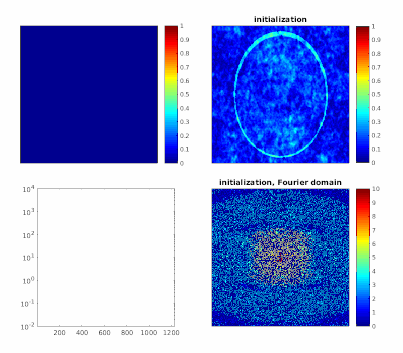GIRAF: Generic Iterative Reweighted Annihilating Filter
MATLAB implementation of the GIRAF algorithm for convolutional structured low-rank matrix recovery problems arising in inverse problems in imaging and signal processing. One of the main applications for GIRAF is in undersampled MRI reconstruction with continuous domain compressed sensing regularization penalties. These penalties model certain compressible properties of the image (e.g., sparsity, gradient sparsity, smooth phase, etc.) by specifying that a convolutional structured matrix built from Fourier data should be low-rank.
Optimization problem
GIRAF is designed to solve following the optimization problem:
||Ax-b||2+λ||T(x)||pSp (OPT)
where x is a mutli-dimensional array of data (typically in Fourier domain), A is a linear measurement operator, b is the measured data, T is a matrix lifting operator that maps the data x to a Toeplitz-like matrix, ||.||Sp is the Schatten-p quasi-norm (0 <= p <= 1), and λ is a regularization parameter.
The GIRAF algorithm solves (OPT) by an iterative re-weighted least squares approach that can be interpreted as alternating between two subproblems: (1) updating an annihilating filter for the data, and (2) solving for the data that is optimally nulled by the annihilating filter in a least-squares sense The animation below shows the iterates of the GIRAF algorithm in the recovery of a piecewise constant image from missing Fourier data. The annihilating filter (here shown in image domain) encodes the edges of the image:
References
GIRAF was introduced in the conference paper:
[1] Ongie, G., and Jacob, M. "A fast algorithm for structured low-rank matrix recovery with applications to undersampled MRI reconstruction." Biomedical Imaging (ISBI), 2016 IEEE 13th International Symposium on. IEEE, 2016.
A full-length journal version of this work is available as a pre-print:
[2] Ongie, G., and Jacob, M. "A fast algorithm for convolutional structured low-rank matrix recovery." Online at: https://arxiv.org/abs/1609.07429
GIRAF is also used in the following paper:
[3] Balachandrasekaran, A., Ongie, G., Jacob, M. Accelerated dynamic MRI using structured low rank matrix completion. InImage Processing (ICIP), 2016 IEEE International Conference on 2016 Sep 25 (pp. 1858-1862). IEEE.
Code Details
A standalone implementation of the algorithm is available in giraf.m.
Demos illustrating GIRAF for undersampled MRI reconstruction are provided in:
giraf_demo1.m- recovery of noiseless undersampled datagiraf_demo2.m- recovery of noisy & undersampled datagiraf_demo3.m- effect of filter size on recon quality
Reproducible Research
The code to reproduce the numerical experiments reported in the paper [2] is provided in the subfolder reproduce
This includes implementations of other commonly used algorithms for solving (OPT), including
singular value thresholding and alternating projections.
